 |
| Cast of The Bling Ring |
 |
| Katie Chang as Rebecca in The Bling Ring |
 |
| Emma Watson as Nicki in The Bling Ring |
 |
| Ladies of The Bling Ring |
The radical notion that women like good movies
 |
| Cast of The Bling Ring |
 |
| Katie Chang as Rebecca in The Bling Ring |
 |
| Emma Watson as Nicki in The Bling Ring |
 |
| Ladies of The Bling Ring |
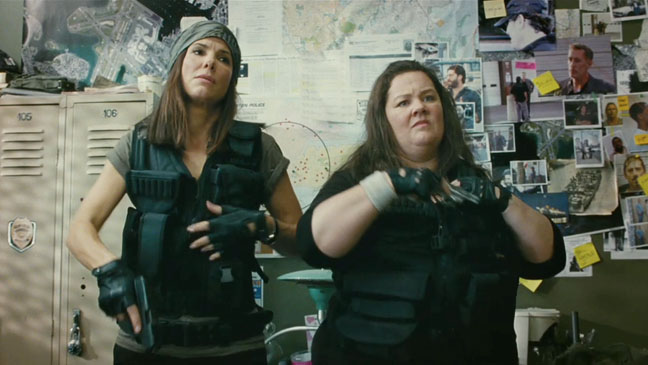 |
| Sandra Bullock and Melissa McCarthy in ‘The Heat’ |
Written by Megan Kearns.
I was extremely excited to see The Heat. Sandra Bullock and Melissa McCarthy, both of whom I love, headlining a comedy? As a huge fan of Bridesmaids, seeing self-proclaimed feminist Paul Feig direct another lady-centric comedy got me giddy with excitement. AND with Bullock and McCarthy??? Yes, please! I don’t care what anyone says, Sandra Bullock is a fantastic actor, even in shitty films. And McCarthy is hilarious.
 |
| No, no, no, just no |
And there’s Mullins’ five-minute (supposedly humorous) tirade on the size of her boss’ balls. How his balls are little “girl balls.” That’s right, let’s insult a guy by insulting the size of his testicles. Only “real” men have balls. Wait no, only “real” men have big balls. Newsflash, masculinity isn’t tied to scrotum size. And trans men may not have balls at all. They’re still men.
Then of course there’s DEA Agent Craig, aka The Albino. Did anyone else cringe at this?? God I hope so. Albinism is a disability. So now we’re making fun of people with disabilities for “looking like evil henchmen” and calling them “Snowcone??” Make it stop.
With all the offensive “jokes,” I was expecting fat-shaming jokes too. I loved that Melissa McCarthy’s weight was never an issue in the film. No jokes were made about her weight. Oh wait, I take that back. DEA Agent Craig tells her she looks “like the Campbell soup kid all grown up.” Really? We see Mullins as a sexually confident, assertive woman and we can’t get away without some fat-shaming snark? There is however an epic take-down of the horrors and toxicity of beauty culture in the form of Spanx. Yes, I’ve worn them, yes they are a demonic torture device. This was especially awesome considering the hideously disgusting fat-shaming vitriol Rex Reed spewed at McCarthy.
 |
| Screw you, Spanx! |
But I have to say that while part of me is delighted to see different depictions of gender presentation, particularly non-stereotypical depictions of beauty (not every woman wants to wear dresses and lots of make-up), does Melissa McCarthy always have to be in slovenly clothes or ridiculous costumes in every movie I see her in?? She’s a beautiful woman. But it’s as if the films she’s in don’t believe that a plus-size woman can be. Why can’t we see a plus-size woman looking different? Or for that matter, why can’t we see more women of all sizes on-screen??
I did love Bullock and McCarthy’s camaraderie and watching their friendship unfold. And it’s fantastic to see two women over the age of 40 headlining a blockbuster movie. Especially when Hollywood abhors aging women and suffers from massive amounts of ageism. And you could tell they had a fucking blast making this movie. It was also awesome to not have a romance in the film, an aspect that delighted Feig as well. While there were flirtations, no romance upstaged the film. The ladies’ sisterhood took center stage.
While there’s very little commentary on gender and sexism, and an ass load of misogyny spewed by DEA Agent Craig — Sidebar, is that why it’s okay to make fun of his disability, because he’s a douchebag?? No, no, no — Ashburn and Mullins kind of “blow off misogynistic bullshit.” But thankfully there’s a very brief and subtle commentary on sexism in the workplace amidst a conversation between Ashburn and Mullins at a bar about how hard it is to be a woman in this line of work.
But did it have to follow in the shadow of buddy-cop movies by also containing transphobic, ableist and racist jokes? Couldn’t it have done without that??
Sadly I wasn’t a huge fan of The Heat. I wish I had been. But I just couldn’t get past the extremely problematic humor. Sigh. I wish it hadn’t been so racist, ableist or transphobic. I wanted to like this, especially because it was written by Katie Dippold, a writer and producer of my fave feminist TV show Parks and Rec. But feminism isn’t just about gender equality and putting more women in film. Although that’s a huge start. It’s about combating all forms of institutional discrimination and oppression. And not perpetuating prejudice.
 |
| If only ‘The Heat’ could have been as awesome as these ladies. |
Despite its flaws, I wholeheartedly believe we need more female-centric films. Way more. And you know what? I’d rather have a female-centric movie I’m not a big fan of rather than none at all.
I’ve read that author (and very funny tweeter) Jennifer Weiner doesn’t like to criticize or speak negatively about books by other female writers because she knows how difficult it is for women to get published. And then when they do, male authors get reviewed more often, and typically by male critics, since gender disparity exists in the critic world too.
And I totally get why she does this. Sisterhood and solidarity can be extremely powerful. There’s a dearth of female film directors, female-fronted films, female screenwriters, female film critics. So I always feel guilty when I don’t lavish a female-centric/penned/directed film. But here’s the thing. I really shouldn’t have to worry about whether or not my critique is going to derail other female filmmakers. Not that I’m saying my words carry as much weight as say NY Times’ Manohla Dargis or anything. But I don’t want to add to the din of voices hyper-scrutinizing women-led films.
Then I can critique a film to my heart’s content without worrying that some asshat in Hollywood thinks they shouldn’t greenlight more women-centric films. Hollywood never thinks to stop making movies with male protagonists. One shitty dude-centric movie? Bring on more dude films. A shitty women-centric movie?? All lady movies must suck.
 |
| Lyrics from The Beatles’ Help!: “When I was younger, so much younger than today” |
You wouldn’t know it by looking at me, but my body is pretty much attacking me from the inside. My blood tests have revealed a severe inflammatory condition, and x-rays and MRIs have indicated early signs of spinal arthritis. I have been diagnosed with fibromyalgia syndrome, which is a lifelong condition under the same umbrella as multiple sclerosis and lupus. I am relatively lucky in that my FMS will not kill me…but there’s no promise that the cyclical depression won’t kill me instead.
I continue to write because I have nothing else to offer of myself. I couldn’t finish my degree, and I couldn’t return to the civil service job I was really good at. Instead, I live off of a small disability income (well under the poverty line, I might add) provided by the Ontario government. Sometimes I have to use the services of my local food bank. Conservatives act like those living on disability are just lazy people sucking up tax dollars, but I can assure everyone reading this that a person cannot feel lower than when they have to beg friends and strangers to feed them and lend them money. It’s a position of utter desperation and degradation. So fuck you, conservatives. Until you have lived like a disabled person lives every fucking day of their lives, you have no right to say a goddamn word. You have no right to judge. And, I’ll remind you–I PAID THOSE FUCKING TAXES TOO.
I write to keep myself going, and to keep myself sane. But there are some days, and some weeks, where I can’t write. I have severe chronic joint pain. Imagine the aches and pains you get when you have the flu. Now imagine dealing with those pains all day, every day. I cannot stand for longer than 10 minutes. I cannot walk without pain and stiffness. I cannot sit up without a pillow and/or an ice pack or heating pad, and even then I need to take breaks to move around every half hour. I am dizzy. I get migraines. I am exhausted all the time–and I’m talking “I have to go to sleep NOW” exhausted. My medication gives me severe side effects.
 |
| Lyrics cont’d: “I never needed anybody’s help in any way” |
When I prepare to write a review for my blog and/or Bitch Flicks, although the pieces are usually short, they often feel like a major university assignment because of the amount of effort it takes for me to finish them. I would write more often if I could. But sometimes, after finishing writing, I feel like I’m going to faint. If I push myself too hard, I can easily end up in the hospital.
First, I have to come up with a film or TV show I can babble feminist theory about. I fortunately have a knack for this sort of thing, but it’s harder than it looks. Back to the Future is my favourite film, but there is literally nothing feminist I can note about it besides pointing out a Bechdel Test fail. And I don’t exactly feel like condemning something that I love. The reality is that the vast majority of films and TV shows lack feminist themes/representation. And that’s a hard reality to write around, because I hate giving negative reviews.
I always do a rewatch of the film/TV show, and take notes, before I write about it. If you’ve ever wondered why I review so few TV series, it’s because they take so long to watch–even the short BBC ones. There is a good chance I will pass out while I’m watching a film. Imagine being in a university class and trying to take notes, and then falling asleep right in class. That’s what I have to struggle against. Every week.
Then I have to make sense of my notes and decide what direction I’m going to take in the blog post. Do I do a character analysis? Do I discuss representation of minorities? Do I praise the media? Do I condemn it? Do I write formally? Do I write satirically? Do I have anything to say about this film whatsoever?
 |
| Lyrics cont’d: “But now these days are gone I’m not so self assured” |
I gave myself a little extra work by deciding to incorporate animated gifs into my reviews. They don’t really take too long–10 minutes per gif, on average. The real time sucker is when I add captions to the gif, because I have to edit every single frame and make sure the text is consistent. I could just stop doing them, but I actually have something unique to offer. For once. The gifs don’t exhaust me nearly as much as the writing does, which is nice, but I’m likely to make mistakes when I’m fighting off sleep.
Then I post the review, and hope people will read it. The majority of my reviews get ignored, especially if I review a film that is older and lacks a cult audience. It’s demoralizing and damaging to the ego. I should get used to it when something I write isn’t noticed. I still have no idea why or how some of my reviews became popular, but others didn’t. The Sailor Moon and Last Unicorn reviews continue to get thousands of hits on Bitch Flicks. The Addams Family review continues to get passed around on Tumblr. I love that some of the things I have written are successful. But when I have just busted my ass on something that nobody besides family and close friends bothered to read…it makes me not want to try anymore. I mentally beg to those readers, “This is not all I have written. Please don’t just move on. Read what else I have to offer. Or else I have nothing.”
And I think that reaction is the depression talking. I have so much trouble finding joy in things that I start to take the good things for granted. I have something I can give to the world, but sometimes no one wants it. Why continue to write? Why not continue to write? I could just say “I’m done, buh bye” and begin an existence of sleeping all day and listlessly consuming media. But that’s not enough for me. Even if no one reads my work…it’s something I was born to do. It’s the last thing that my broken body can give.
 |
| Lyrics cont’d: “Now I find I’ve changed my mind, I’ve opened up the doors” |
So if I miss a week when I write a blog post, please forgive me. I don’t do it on purpose, because, despite it all, I still love to write. There are so many thoughts in my head, I have to put them down somewhere. I’ll do the best that I can. There is little hope for me, but at least my mind still works and my fingers can still type. I’ll work myself to exhaustion just so I can get some thoughts out there.
All I ask is that you read them.
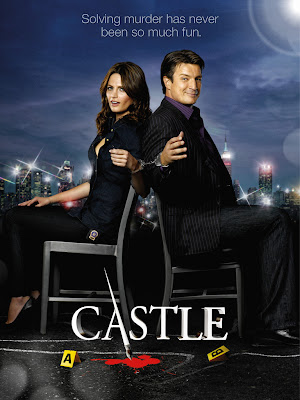 |
| Castle’s Season 3 promo. |
Written by Janyce Denise Glasper
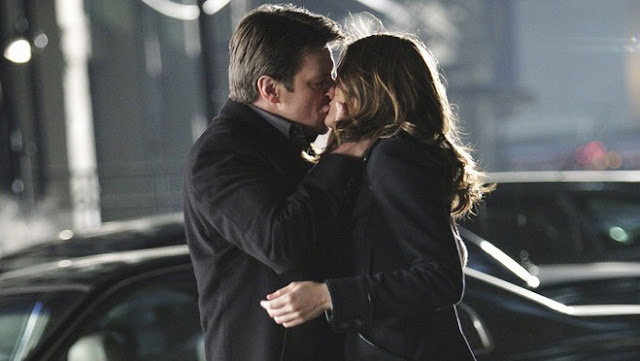 |
| Castle (Nathan Fillion) and Beckett (Stana Katic) put on a kissing act. |
“Even when we were married you built a wall around Alexis like you didn’t want anyone to be close to her. When it came to the two of you I was always on the outside looking in.”
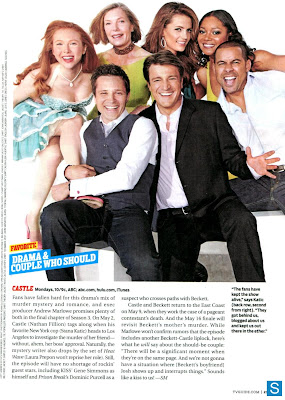 |
| Season three Castle cast: top- Molly Quinn (Alexis), Susan Sulllivan (Martha), Stana Katic (Beckett), Tamala Jones (Lanie), bottom- Dever (Ryan), Nathan Fillion (Castle), and Jon Huertes (Esposito). |
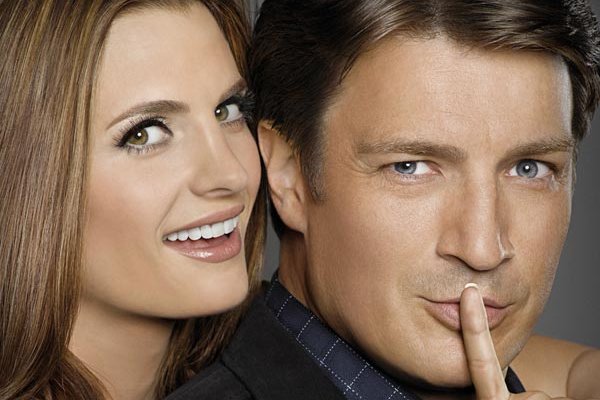 |
| Castle‘s season four promo with Beckett (Stana Katic) and Castle (Nathan Fillion). |
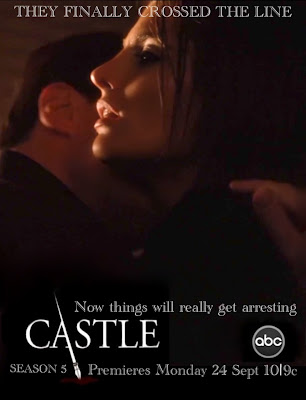 |
| No longer fun & witty, sex is selling Castle‘s season five promo. |
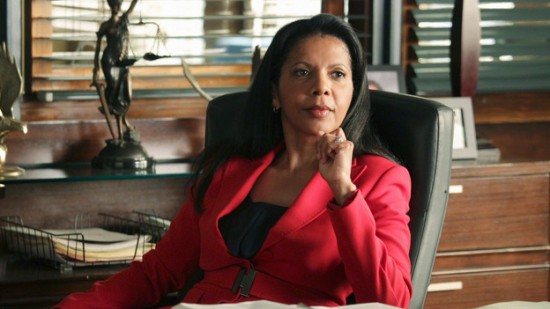 |
| Penny Johnson Herald as Captain “Iron” Gates in Castle. |
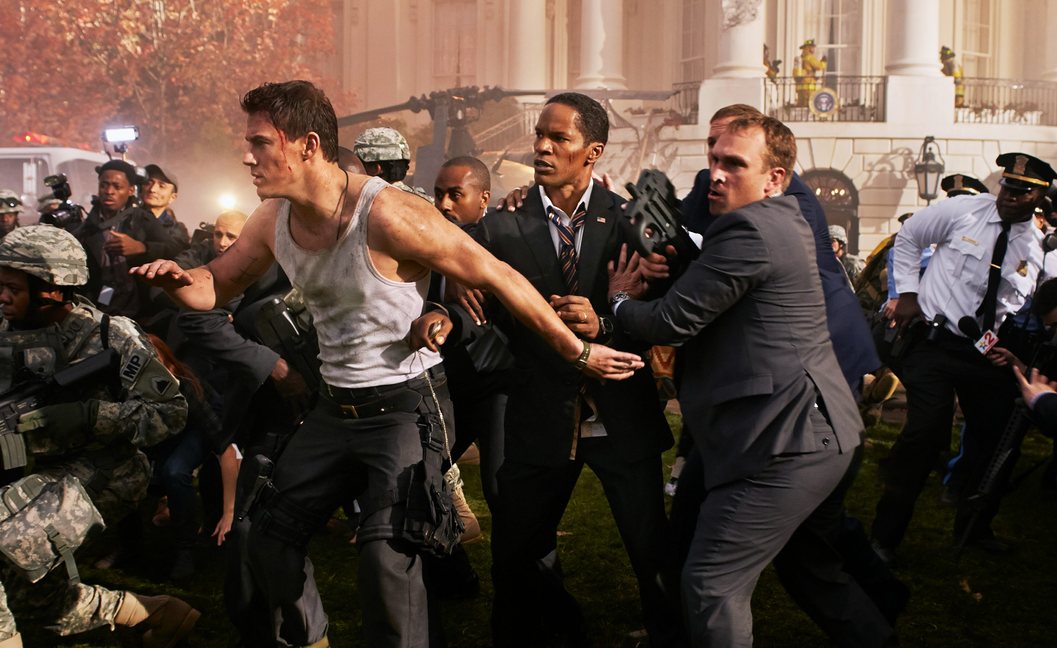 |
| Channing Tatum, Jamie Foxx, and a billion other dudes in White House Down. I swear there are chicks, though. |
 |
| Carol Finnerty (Maggie Gyllenhaal) |
 |
| No images of this character or actress exist so I’m taking the Ms. Pac-Man approach. |
 |
| Emily Cale (Joey King) |
 |
| Photo of my old project binder |
 |
| Stories of the Unconscious logo–an original lino print |
 |
| One of the many ways we sold our souls for crowd-funding dollars |
 |
| A still from “The Statue,” one of the nine stories that make up Stories of the Unconscious. Cinematography by Alex Hill. |
 |
| The studio work table |
 |
| A shot of the central character on the set of our stop motion animation |
 |
| Damon making columns for the set of “In the Well” |
| Unveiling the trickery of forced perspective: the beginning of some urban house facades |
 |
| Cait on the set of “Smells Like Chewing Rubber” |
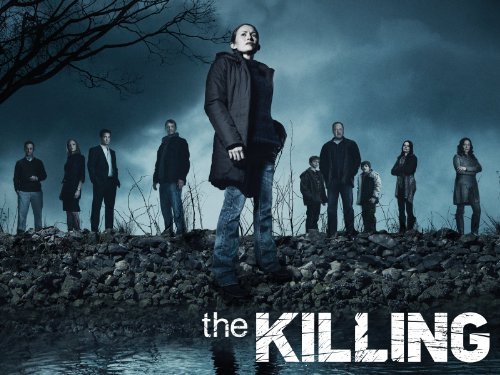 |
| The Killing promotional still. |
Written by Leigh Kolb
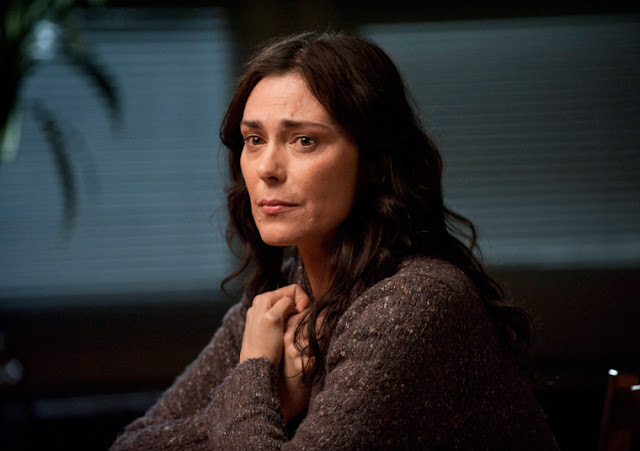 |
| Mitch Larsen: bad mother. |
“Her daughter may or may not have been a prostitute or involved in some illegal doings at a casino. And she ended up dead seemingly because of it. But instead of hunkering down and paying more attention to her remaining children, Mitch left her sons to be raised by a depressed father and their hooker aunt while she went off to live in a motel and act creepy around wayward runaway girls.”
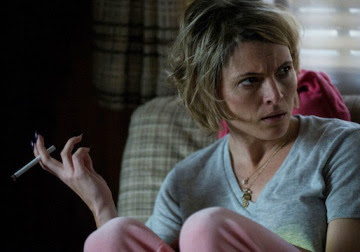 |
| Danette: bad mother. |
While these supporting characters’ relationships with their daughters are troubled, and it would be easy for the audience to “blame” the victimization of the daughters on their mothers, it wouldn’t be correct. We are so used to complex, fallible male characters that we are also conditioned to see them as complex and fallible, not good or evil. When we’re presented with women with the same depth of characterization–especially mothers–we don’t know what to do except what we’ve been conditioned to do: criticize them and blame them.
This is blatantly obvious when we consider the show’s protagonist, detective Sarah Linden (played by the amazing Mireille Enos).
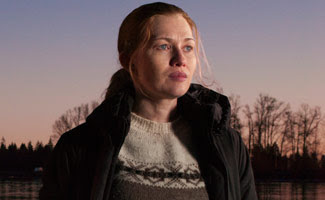 |
| Sarah Linden: bad mother. |
“We all struggle with the work-life balance thing, and detective Sarah Linden is hardly an exception. Finding time to mother her son, for instance, seems to be a challenge. Jogging, however, she manages to squeeze in. And it’s a good thing, too. Because Linden (finally) got a major break in the case this week, and it’s all thanks to the fact that she prioritizes cardio over sleep, parenthood, marriage, friendship, or updating a sweater collection that appears to have been sourced from Dress Barn circa 1997.”
“But she’s still the World’s Worst Mother — her son lives in Chicago and she won’t visit because, well, he’s the only person she knows there. Wow, Linden. Just, wow.”
In a Salon review from last year (which, remarkably, denounces The Killing for not being “fun” enough), the reviewer slips in, “Yes, it’s still raining, and Linden’s still a bad mother…”
“Sarah Linden refuses to accept that her inattentiveness is gravely affecting her son until she is forced to reckon with her absence around him. And in Mitch Larsen (Michelle Forbes) we bear witness to a character who is present in her daughter’s life and yet still positioned at a significant remove from the darkest secrets of her adolescence. In the end, of course, this is the scariest aspect of all.”
At Bitch Flicks, Megan Kearns posted in the first season how it was “refreshing” to see this kind of character trying to navigate her different roles, and that “the lead character is an accomplished single mom striving to keep her son out of trouble all while maintaining her demanding career.” She manages to do that by the third season, but it’s still not good enough.
Instead, audiences and critics alike focus much too closely on the female protagonist’s failings as a mother. We do not do that with male protagonists. (OK, six seasons in, after an episode highlighting parenting, Jezebel posted about how Don Draper was a “shitty dad.”)
Is Dexter a good father? What about Rick Grimes? Walter White?
Certainly there are lists of “bad dads” in TV/film, but the tone is different, more tongue-in-cheek. And a focus on these characters’ fathering abilities doesn’t run throughout conversations about the show, especially not with the same venom we see about Linden. When there’s a bad father in the mix, it’s just a poignant piece of a Joseph Campbell hero’s journey. Bad mothers, however, deserve to be burned at the proverbial stake.
There is a dearth of female antiheroes in film and television. The response to Sarah Linden shows why this is. When audiences see female characters, they think primarily in critical terms, especially about their roles as mothers and wives. (Of course this extends past fictional characters; there’s consistent and persistent hand-wringing about real-life women working too much and not being good enough mothers.) Women aren’t perfect (especially within the narrow confines of perfection that our society has put in place). Female characters shouldn’t be perfect.
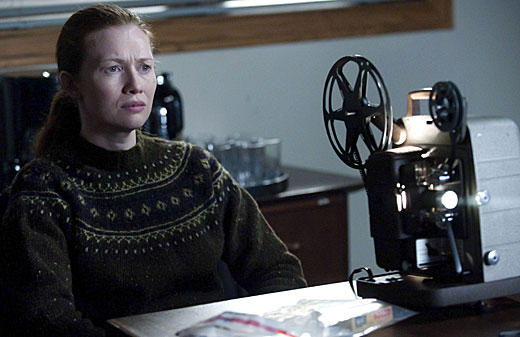 |
| My son is doing fine and my sweaters are warm and comfortable, assholes. |
Linden’s role as a parent, girlfriend and ex-wife is just one small part of the grand scheme of the show. Her partner, Stephen Holder, has a girlfriend this season. He forgets Valentine’s Day and is never home. He is not painted as a villain, because he’s out getting shit done. He’s doing his job. That is what is important in The Killing. So when critics focus (in depth, or just in passing) on how terrible a mother Linden is, that further erodes what should be good about having strong, complex female characters.
 |
|
| In the House movie poster |
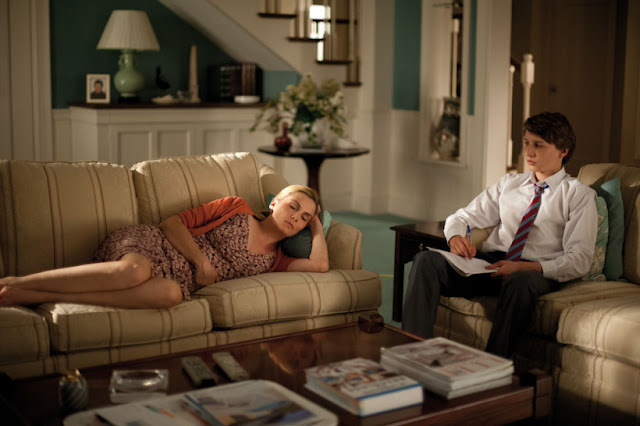 |
| Esther sleeps while Claude voyeuristically writes about her feet. Women, he finds, are easier to admire when they’re asleep and can’t challenge him or make him feel inadequate. |
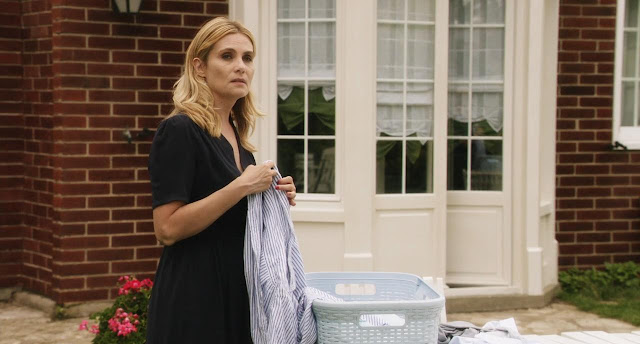 |
| Esther folding laundry, noticing Claude staring at her from a park bench. |
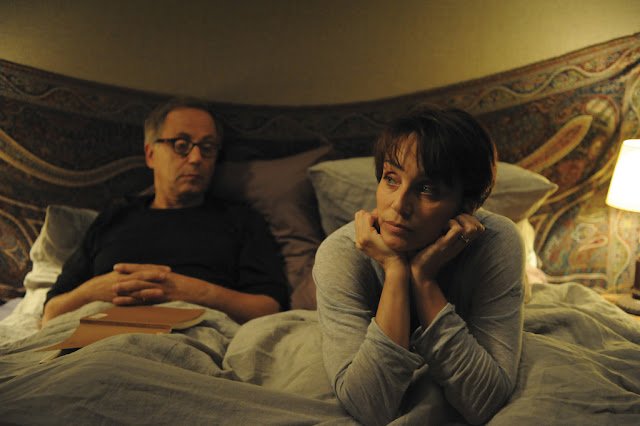 |
| Jeanne sits in bed contemplating the tale Claude weaves as well as the nature of the weaver himself. |
 |
| Germain is horrified that Jeanne has invited the Artoles, as he’d prefer to imagine them as fictitious. |
Not only does Germain become completely unsympathetic to me in that moment, but the female characters are revealed to be little more than narrative devices. The ending of In the House makes it clear that the film was always and only about the relationship between Germain and Claude. As the two sit together on a bench bereft of everything but each other’s company and their stories, it becomes clear that the narrative was always about the power play between instructor and pupil. Other people were merely obstacles that stood between them to be maneuvered like chess pieces until these two men were on equal footing, a sort of stalemate with only the kings left standing on the board.
At first, I hoped the film was calling attention to the way that both Germain and Claude don’t really see the women in their lives, don’t allow them to be full human beings, but upon further analysis, it becomes apparent that the film itself only uses the female characters as convenient props to help elucidate the male narrative replete with its masculine struggles.
Movie Review: Rachel Getting Married by Stephanie Rogers
Rachel Getting Married: A Response by Amber Leab
Documentary Preview: Arusi Persian Wedding by Amber Leab
Review in Conversation: Sex and the City: The Movie by Stephanie Rogers and Amber Leab
Bachelorette Proves Bad People Can Make Great Characters by Robin Hitchcock
Feminism in Aiyyaa and Why It Ain’t Such a Bad Movie by Rhea Daniel
Realistic Depictions of Women and Female Friendship in Muriel’s Wedding by Libby White
Romantic Comedy (and Female Friendship) Arranged Marriage Style by Rachel Redfern
Movie Review: Something Borrowed by Megan Kearns
Movie Review: Melancholia by Olivia Bernal
The Five-Year Engagement: Exploration of Gender Roles & Lovable Actors Can’t Save Rom-Com’s Subtly Anti-Feminist Message by Megan Kearns
Bros Before Hoes, or How Kidnapping Makes for Great Dance Numbers: On Seven Brides for Seven Brothers by Jessica Freeman-Slade
Movie Review: Melancholia by Hannah Reck
Melissa McCarthy in Bridesmaids by Janyce Denise Glasper
“Love” Is “Actually” All Around Us (and Other Not-So-Deep Sentiments) by Lady T
Everything You Need to Know About Space: 10 Reasons to Watch (and Love!) Imagine Me & You by Marcia Herring
The Reception of Corpse Bride by Myrna Waldron
Movie Review: Room In Rome by Djelloul Marbrook
Movie Review: 500 Days of Summer by Stephanie Rogers
(95) Minutes of Pure Torture: 500 Days of Summer by Deborah Nadler
Gay Rights and Gay Times: Gender Commentary in Husbands by Rachel Redfern
Bridesmaids: Brunch, Brazilian Food, Baking, and Best Friends by Laura A. Shamas
The current Hollywood climate and the overwhelming ridiculousness of most of the big blockbusters being churned out of that machine is something that we talk about a lot over here at Bitch Flicks. The problems with a lack of unique female characters, general lack of original plot and substantive dialogue are just a few of the major problems going on right now. But on top of that has been a trend I recently noticed concerning our portrayal of sex trafficking as a tool to demonstrate the general kick-ass, uber-masculine, damsel-in-distress saving, action star. Specifically, I’m talking about the films Taken, Taken 2, and Trade.
In this case, the horrific abuse that is the daily life of many sex trafficking victims is wantonly used as mere shock factor, and in the process, allows a seedy voyeurism of the acts of torture and sexual assault that happen in such films. Does it do more harm or good to have such shocking and graphic scenes portrayed so cavalierly? For instance, the harm comes from using shocking scenes as a way to drive up viewership and glamorizing a very real global human rights violation; the good comes from the fact that these intense films do have a large viewership and in that, those films can spread awareness of the issue.
The issue is a complicated one and I have written about it for other venues here, but despite the fact that there are some very problematic films about sex trafficking running around out there, there are also some very good ones. Specifically, the 2012 film, Eden, directed by Megan Griffiths and just released on DVD last month.
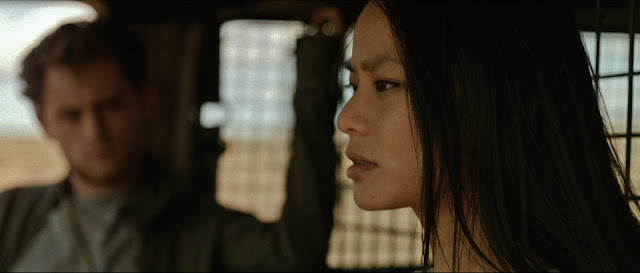 |
| Jamie Chung as Eden |
Eden is based off the true-life story of Chong Kim (Jamie Chung), a young Korean American woman who was kidnapped and sold into sex slavery in the United States. Many do not realize that the United States is unfortunately a huge participant in the importation and the exploitation of immigrations and US citizens in the global sex trafficking trade.
Eden chronicles Chong’s two years of experiences in a well-connected, organized prostitution ring within the American Southwest. Chong (renamed Eden by the organization) begins to climb the ladder of her own organization as a way to survive and eventually escape, an action that fully demonstrates the twisted reach of the organization.
Eden is a slow-moving tale, one that takes time to develop and highlight the changes and trauma that are influencing Chong, allowing the story, and Chong’s character, to grow as a result. The film is episodic in nature, skipping ahead to highlight significant moments within her capture and showcasing the passage of time.
As well, the fact that the United States has a substantial piece of the sex trafficking trade is exposed in this film. Eden is grounded in the US experience, even showing Chong within a standard US suburb being shuttled too and from homes as a prostitute. The landscape is familiar, as are the men and women she comes into contact with; it’s horrifying to realize how easily sex trafficking and its victims slip in and out of American life.
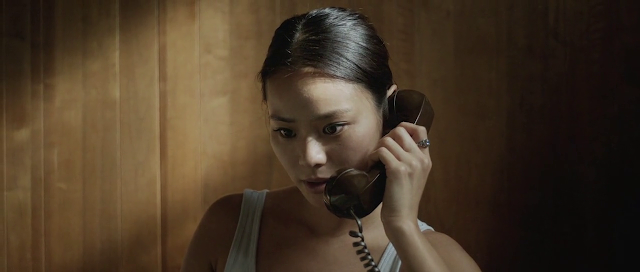
Jamie Chung as Eden–making her way up the ladder of the organization
Chong is an American citizen, and Eden portrays how many of the women are young American youths who have been sold or have run away from home. But Chong also has Asian heritage from her Korean parents, which means that in the film she must pretend to be an underage Chinese prostitute as a gimmick to get clients, a horrifically true detail that Chong Kim talks about here in an excerpt (page 11-12). Immigrants are usually considered the largest target of sex trafficking. It’s horrible to realize that such a situation is considered sexually desirable by some who use prostitutes.
But the film never explicitly shows the rape or torture scenes. We are aware of what’s happening and even of the effect that these actions have on Eden, but neither are we made to be participants in the same actions that the film is portraying. In fact, in this instance, not showing is a far more effective tool in demonstrating the seriousness and reality of sex trafficking. Instead of the focus being placed on the gratuitously violent rape-torture scene, the focus can instead be placed on how this trauma is affecting her, how the organization operates, and its insidious place within much of mainstream society.
Rather than focusing on the big man coming to save her, Eden is about her experiences, how she learns to survive, how she uses her own resources to facilitate her escape. That’s not to say that sex trafficking victims should in any way shape or form be responsible for their removal from sex trafficking, but it is important that films don’t just use sex trafficking as an action movie plot device.
Eden may be a little slow-moving, and I think it could have been longer, giving even more time to show Eden’s development and the effects of sex trafficking, but on the whole, Eden is a fine independent film, by a young and upcoming female director. We need more films telling subtle and focused stories about the thousands of victims of sex trafficking around the world.
 |
| Sarah Michelle Gellar as Buffy Summers |
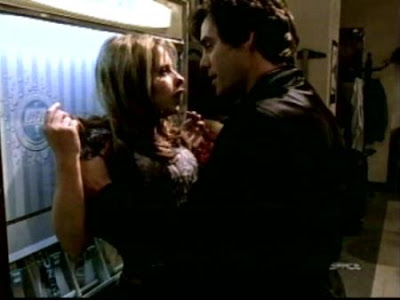 |
|||
| Xander (Nicholas Brendon) attacks Buffy while possessed |
“Xander isn’t accountable for what he said or did under the hyena possession. I think unintentional, accidental possession by demonic spirits is about as extenuating a circumstance you can get … I do, however, think that the attempted assault scene reveals something less than pleasant about Xander’s character. No, he would never attack Buffy when he was in his right mind, but he does believe that she’s attracted to dangerous men–that if he were dangerous and mean, she would be attracted to him.”
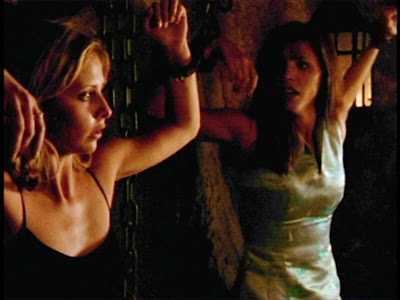 |
| Buffy and Cordelia (Charisma Carpenter) wait in terror for the frat boy demon to arise |
“Even before this scene, we knew that Richard was a bad guy and that the Delta Zeta Kappa guys were up to no good, but we were also led to believe that Buffy’s date, Tom, was the nice guy of the group. We think he’s the only good one of a group of potential rapists, and when he pulls Richard off of Buffy’s unconscious body, our initial inference is confirmed–until we see that Tom is just as bad as the rest, if not worst of all. He was only pretending to be nice to make Buffy trust him. The message is clear: even guys who pretend to be nice and unassuming can be dangerous, and you can’t assume that a self-deprecating ‘nice’ guy is actually a good guy.”
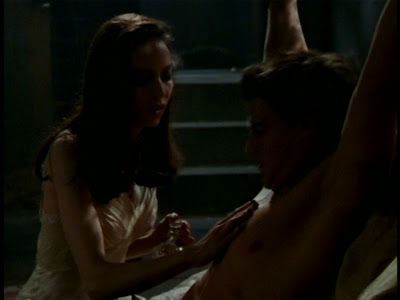 |
| Drusilla (Juliet Landau) begins her torture of Angel (David Boreanaz) |
“I’ve often thought that Drusilla is the most tragic character on Buffy, and that’s largely because of her relationship with Angel. I think her obsession with Angel is a commentary on molestation and Stockholm Syndrome. I’m not sure how old she was when Angel and Darla turned her into a vampire, but these episodes and a few flashbacks on Angel indicate that she was pretty young, maybe on the verge of turning eighteen. However old she was, the point is that she was ‘pure, sweet, and chaste’–qualities that made Angel obsessed with her, made him want to corrupt her innocence.”
 |
| Buffy and Angel, shortly after escaping death and before sleeping together |
“Even though Buffy and Angel sleeping together is wrong from a legal perspective, I have a hard time categorizing this incident as rape. Defining it as rape would rob Buffy of her agency in making that choice to sleep with Angel. She knew exactly what she was doing in the heat of the moment. She wasn’t under the influence of anything, she wasn’t hesitating for a second, and she wanted it to happen … At the same time, Buffy is barely seventeen, and Angel is two hundred and forty. Angel having sex with Buffy at her age and her level of experience is … well, it’s a little gross.”
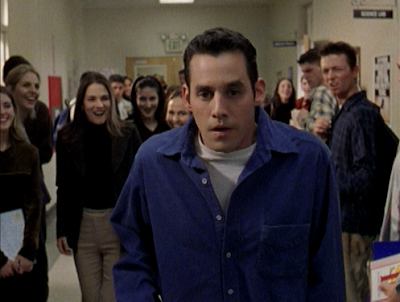 |
|
| Xander walks down the hallway with every girl in Sunnydale High ogling him |
“Xander temporarily making Cordelia fall in love with him just so he can break her heart is gross, cruel, and inexcusable (even though I do empathize with his hurt feelings). But imagine if he had wanted Cordelia to love him forever, if the love spell had worked and was permanent, that he slept with her, married her, spent his life with her, all while her feelings for him weren’t real. A temporary love spell for the purpose of revenge is stupid and malicious, but a permanent love spell inspired by ‘pure’ intentions is a much, much bigger violation of consent and autonomy. Yet the second of the two would be considered more ‘romantic’ in our society.”
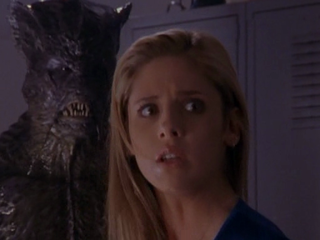 |
|||
| Buffy worries more for her reputation than her safety |
“This episode has a lot of victim-blaming and slut-shaming. Buffy is the one who is attacked, but she’s blamed for dressing inappropriately. She defended herself–something that assault victims are always encouraged to do–but only further incriminates herself in the process. Sure, Cameron does have a broken nose, and Buffy doesn’t appear to be injured, but his word is automatically taken over hers. He’s worth more to the school administration. He’s a successful athlete who brings acclaim and honor to the school, and she’s a violent troublemaker. Buffy’s not the ‘right’ kind of victim.”
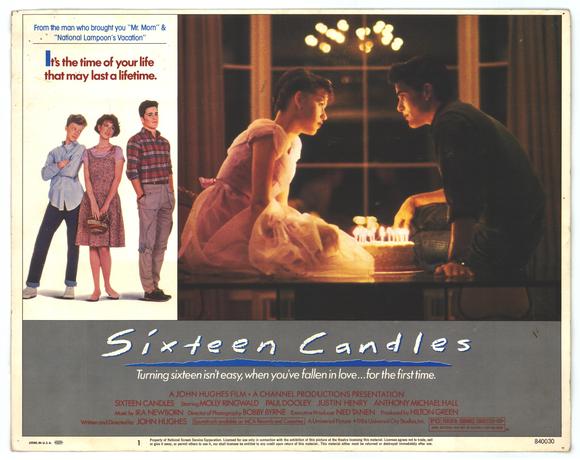 |
| Movie posters for Sixteen Candles |
Written by Stephanie Rogers (but not in time for Wedding Week).
Holy fuck this movie. I started watching it like OH YEAH MY CHILDHOOD MOLLY RINGWALD ADOLESCENCE IS SO HARD and after two scenes, I put that shit on pause like, WHEN DID SOMEONE WRITE ALL THESE RACIST HOMOPHOBIC SEXIST ABLEIST RAPEY PARTS THAT WEREN’T HERE BEFORE I WOULD’VE REMEMBERED THEM.
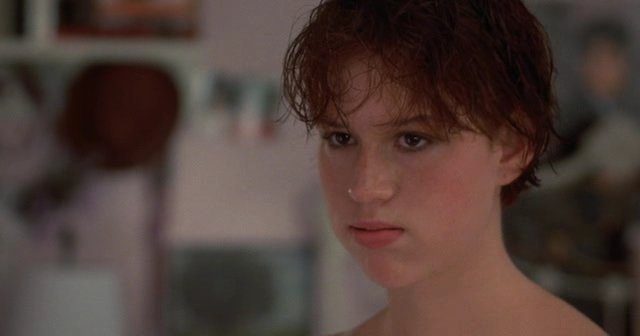 |
| “Chronologically, you’re 16 today. Physically? You’re still 15.” –Samantha Baker, looking in the mirror |
Ted: You know, I’m getting input here that I’m reading as relatively hostile.
Samantha: Go to hell.
Ted: Come on, what’s the problem here? I’m a boy, you’re a girl. Is there anything wrong with me trying to put together some kind of relationship between us?
[The bus stops.]
Ted: Look, I know you have to go. Just answer one question.
Samantha: Yes, you’re a total fag.
Ted: That’s not the question … Am I turning you on?
[Samantha rolls her eyes and exits the bus.]
 |
| Samantha looks irritated when her stalker, Farmer Ted, refuses to leave her alone. Also Joan Cusack for no reason. |
Ted: You see, [girls] know guys are, like, in perpetual heat, right? They know this shit. And they enjoy pumping us up. It’s pure power politics, I’m telling you … You know how many times a week I go without lunch because some bitch borrows my lunch money? Any halfway decent girl can rob me blind because I’m too torqued up to say no.
Jake: I can get a piece of ass anytime I want. Shit, I got Caroline in my bedroom right now, passed out cold. I could violate her ten different ways if I wanted to.
Ted: What are you waiting for?
Jake: I’ll make a deal with you. Let me keep these [Samantha’s underwear, duh]. I’ll let you take Caroline home … She’s so blitzed she won’t know the difference.
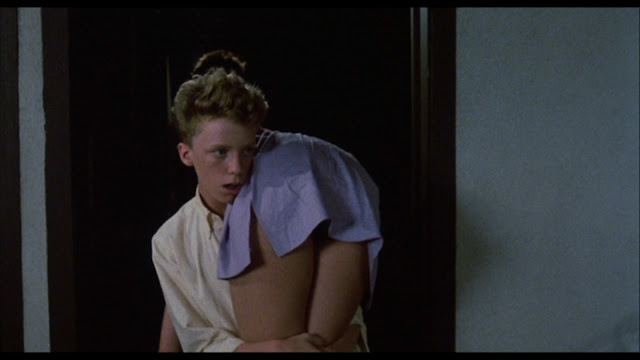 |
| Ted carrying a drunk Caroline to the car |
And then Ted throws a passed-out Caroline over his shoulder and puts her in the passenger seat of a convertible. This scene took me immediately back to the horrific images of two men carrying around a drunk woman in Steubenville who they later raped—and were convicted of raping (thanks largely to social media). This scene, undoubtedly “funny” in the 80s and certainly still funny to people who like to claim this shit is harmless, helped lay the groundwork for Steubenville, and for Cleveland, and for Richmond, where as many as 20 witnesses watched men beat and gang rape a woman for over two hours without reporting it. On their high school campus. During their homecoming dance.
 |
| Jake and Ted talk about how to fool Caroline |
People who claim to believe films and TV and pop culture moments like this are somehow disconnected from perpetuating rape need to take a step back and really think about the message this sends. I refuse to accept that a person could watch this scene from an iconic John Hughes film—where, after a party, a drunk woman is literally passed around by two men and photographed—and not see the connection between the Steubenville rape—where, after a party, a woman was literally passed around by two men and photographed.
 |
| Caroline looks drunk and confused while Ted’s friends take a photo as proof that he hooked up with her |
Ted: Did we, uh …
Caroline: Yeah. I’m pretty sure.
Ted: Of course I enjoyed it … uh … did you?
Caroline: Hmmm. You know, I have this weird feeling I did … You were pretty crazy … you know what I like best? Waking up in your arms.